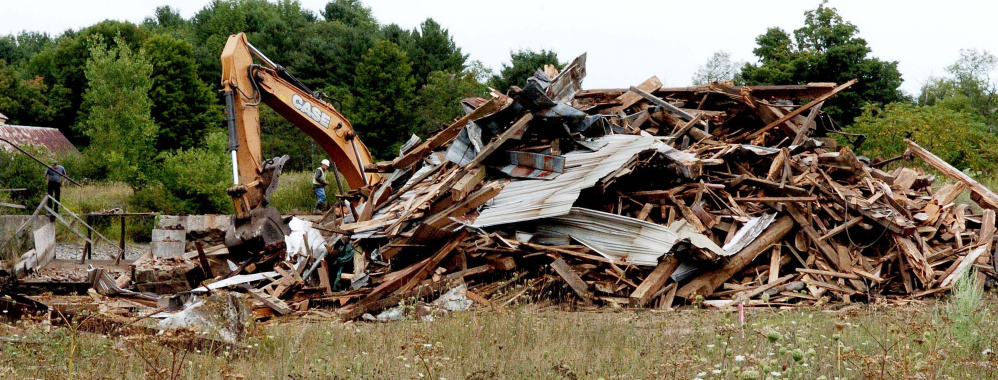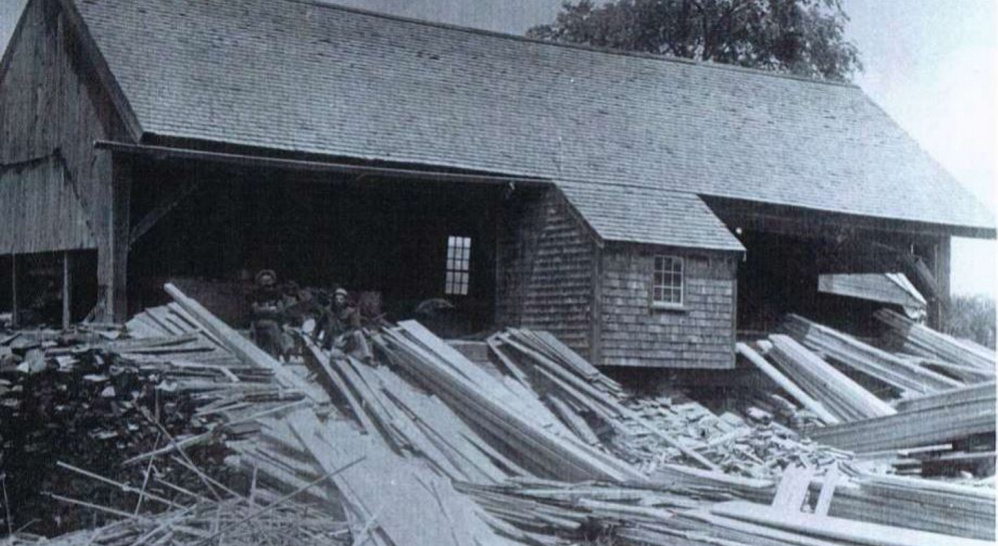VASSALBORO — Around 1800, a sawmill was built along Outlet Stream. In 1912, the sawmill, along with its water power rights and the neighboring grist mill, was sold to the Masse family, who owned the dam.
Donald Robbins, a descendant of the Masse family, is now “presiding over the funeral” of the historic site, which was partially torn down last week.
The Alewife Restoration Initiative, an unofficial collaboration of seven organizations, tore down the sawmill for safety reasons and plans to remove the Masse Dam as part of a project to restore the alewives to China Lake, giving them access through Outlet Stream. The alewife group plans to remove four dams along Outlet Stream and install two fish passageways at other dams.
But not all residents are at peace with the sawmill removal or satisfied with the way the group is conducting the dam removals. Some even protested the removal of the Masse Dam, which was built in 1797.
Robbins is a geologist and has environmental interests in addition to the water company. He and his partner bought the property as a requirement to protect their water source and pipes.
But being a water company, the Public Utilities Commission wouldn’t allow them to borrow money to shore up the building so it wouldn’t collapse. For that alone, estimates from multiple engineers ranged from $250,000 to $300,000, he said.
Demolishing the building wasn’t in their price range either.
In 2013, the Alewife Restoration Initiative came along with a proposal to tear down the sawmill and remove the Masse dam.
“We thought it was such a godsend,” Robbins said. He sold the building to the group, which did the fundraising for the project.
The sawmill was torn down Wednesday. The building was listed on the National Register of Historic Places, so the Alewife Restoration Initiative was required to go through an exhaustive process of documenting the site, according to Landis Hudson, executive director of Maine Rivers, which is part of the alewife group.
Hudson said the group worked to recover whatever historical pieces they could before the building was torn down. Members of the alewife group and officials from the Maine Forest and Logging Museum in Bradley went through the building to retrieve historical pieces to be preserved at the museum, she said.
RESTORING CHINA LAKE
Charlie Hartman lives next to the sawmill on Route 32 and said she is upset that her backyard, which once held a pond, now just looks like mud.
“Everything that we’ve been concerned about has already come to pass,” she said after an Alewife Restoration Initiative meeting.
Hartman said people in Vassalboro are upset about the methods the alewife group have been using to achieve their goals.
“Vassalboro has been trying to get the ARI to work with them for months to get a solution,” she said. “I am absolutely certain that that solution is possible.”
Hudson has said that they are looking to get people’s input, and that is why they are holding informational meetings in the town.
The Alewife Restoration Initiative is working on a years-long project that could potentially revive China Lake.
The lake’s decline didn’t happen overnight. For decades septic systems, fertilizer and road runoff polluted the lake, adding phosphorous which then spawned large algae blooms. It was not only damaging to the aesthetics of the lake, but also the quality and the ecological life.
The 1980s proved to be a “tipping point” for the lake, according to China Lake Association President Scott Pierz. Annual algae blooms started in this time period and the lake’s water quality rating started decreasing.
To revive the lake will take time. Ecologically, China Lake is “dead,” according to Nate Gray, who works for the state Department of Marine Resources, which has been working to restore alewives across the state.
But perhaps the most attractive feature of the alewife for China Lake is that it’s a migratory fish. The only other fish native to the lake that migrates back to the Atlantic Ocean is the eel, which has seen a drastic population drop due to dams.
Alewives spawn in ponds, lakes or rivers and the adults return to fresh water before coming back to spawn in May or June.
When an alewife leaves a lake, pond or river, it takes with it some of the phosphorous from that water. Studies conducted by the state have shown that water quality improves in lakes when alewives are reintroduced.
“It won’t instantaneously reverse the water quality issues of China Lake,” Gray said at an Alewife Restoration Initiative meeting. “But they will help the water quality over the long term.”
Send questions/comments to the editors.





Success. Please wait for the page to reload. If the page does not reload within 5 seconds, please refresh the page.
Enter your email and password to access comments.
Hi, to comment on stories you must . This profile is in addition to your subscription and website login.
Already have a commenting profile? .
Invalid username/password.
Please check your email to confirm and complete your registration.
Only subscribers are eligible to post comments. Please subscribe or login first for digital access. Here’s why.
Use the form below to reset your password. When you've submitted your account email, we will send an email with a reset code.